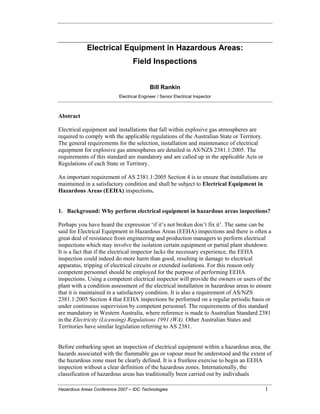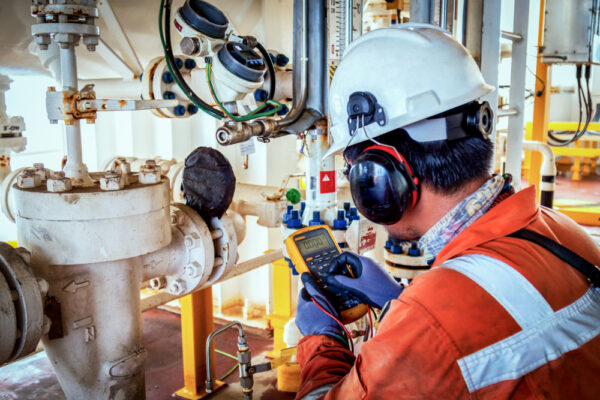Roar Solutions - An Overview
Roar Solutions - An Overview
Blog Article
The 3-Minute Rule for Roar Solutions
Table of ContentsThe Best Strategy To Use For Roar SolutionsRoar Solutions Can Be Fun For AnyoneRoar Solutions Things To Know Before You Get This
In order to secure installments from a possible surge a technique of analysing and categorizing a potentially dangerous area is needed. The objective of this is to make sure the right option and setup of tools to inevitably stop a surge and to make sure safety of life.
(https://www.interweave.com/plus_old/members/roarsolutions/profile/)
No devices needs to be installed where the surface temperature of the devices is above the ignition temperature of the given hazard. Below are some usual dirt dangerous and their minimum ignition temperature. Coal Dust 380C 225C Polythene 420C (melts) Methyl Cellulose 420C 320C Starch 460C 435C Flour 490C 340C Sugar 490C 460C Grain Dust 510C 300C Phenolic Material 530C > 450C Aluminium 590C > 450C PVC 700C > 450C Soot 810C 570C The possibility of the threat being present in a concentration high enough to trigger an ignition will certainly differ from location to location.
In order to categorize this threat an installation is divided into locations of danger depending upon the amount of time the hazardous exists. These areas are described as Areas. For gases and vapours and dirts and fibres there are 3 zones. Zone 0 Area 20 A dangerous environment is very most likely to be present and might be existing for extended periods of time (> 1000 hours annually) and even continuously Area 1 Area 21 A hazardous ambience is possible but not likely to be existing for extended periods of time (> 10 450 C [842 F] A classification of T6 suggests the minimum ignition temperature level is > 85 C [185 F] Hazardous area electric equipment possibly designed for usage in greater ambient temperatures. This would certainly indicated on the ranking plate e.g. EExe II C T3 Ta + 60C( This implies at 60C ambient T3 will certainly not be surpassed) T1 T1, T2, T3, T4, T5, T6 T2 T2, T3, T4, T5, T6 T3 T3, T4, T5, T6 T4 T4, T5, T6 T5 T5, T6 T6 T6 A T Class score of T1 suggests the optimum surface temperature created by the tool at 40 C is 450 C. Assuming the connected T Course and Temperature level ranking for the devices are appropriate for the area, you can constantly use an instrument with a more rigid Department score than needed for the area. There isn't a clear response to this question unfortunately. It really does depend on the type of devices and what repairs need to be executed. Tools with specific test treatments that can't be carried out in the area in order to achieve/maintain third party rating. Need to return to the factory if it is prior to the equipment's solution. Area Repair Service By Authorised Employee: Difficult screening might not be called for nonetheless details procedures may need to be adhered to in order for the devices to preserve its 3rd party score. Authorized employees have to be employed to carry out the job correctly Repair work must be a like for like replacement. New part need to be thought about as a direct substitute calling for no unique screening of the devices after the repair work is complete. Each item of tools with a hazardous rating need to be evaluated separately. These are outlined at a high level listed below, but also for more thorough details, please refer directly to the guidelines.
Roar Solutions Can Be Fun For Anyone
The equipment register is an extensive data source of tools records that includes a minimum collection of areas to recognize each thing's location, technological criteria, Ex-spouse classification, age, and environmental data. This information is crucial for monitoring and managing the devices efficiently within harmful areas. In contrast, for regular or RBI sampling evaluations, the quality will certainly be a mix of Detailed and Close assessments. The proportion of In-depth to Shut assessments will be established by the Devices Risk, which is assessed based upon ignition danger (the possibility of a source of ignition versus the probability of a combustible ambience )and the hazardous area category
( Zone 0, 1, or 2). This variation will likewise influence the resourcing demands for work preparation. When Lots are defined, you can develop tasting strategies based upon the example size of each Whole lot, which describes the number of random equipment products to be inspected. To determine the called for example size, 2 facets need to be examined: the dimension of the Great deal and the category of assessment, which shows the degree of effort that need to be used( minimized, typical, or increased )to the assessment of the Lot. By incorporating the group of assessment with the Great deal dimension, you can after that establish the suitable denial standards for a sample, suggesting the permitted variety of defective products located within that example. For even more information on this procedure, please describe the Power Institute Guidelines. The IEC 60079 common advises that the maximum interval between evaluations should not exceed 3 years. EEHA evaluations will also be carried out beyond RBI campaigns as part of set up upkeep and equipment overhauls or repair services. These assessments can be attributed towards the RBI sample sizes within the influenced Whole lots. EEHA examinations are performed to determine mistakes in electrical equipment. A weighted racking up system is crucial, as a solitary tool may have multiple mistakes, each with varying levels of ignition danger. If the combined score of both evaluations is much less than twice the mistake score, the Lot is regarded appropriate. If the Whole lot is still considered undesirable, it should undergo a complete inspection or reason, which might set off stricter evaluation methods. Accepted Lot: The sources of any faults are identified. If a common failing mode is found, added equipment might call for maintenance. Mistakes are identified by extent( Safety and security, Honesty, House cleaning ), guaranteeing that immediate issues are examined and dealt with promptly to minimize any kind of influence on safety and security or operations. The EEHA database ought to track and tape the lifecycle of mistakes along with the corrective actions taken. Applying a durable Risk-Based Examination( RBI )approach is important for guaranteeing conformity and safety in handling Electrical Tools in Hazardous Locations( EEHA) (Roar Training Solutions). Automated Mistake Rating and Lifecycle Monitoring: Easily manage faults and track their lifecycle to improve examination accuracy. The intro of this assistance for risk-based inspection further reinforces Inspectivity's position as a best-in-class remedy for regulative conformity, in addition to for any type of asset-centric examination usage instance. If you want discovering more, we welcome you to request a demo and uncover how our remedy can change your EEHA administration procedures.
Get This Report about Roar Solutions

In regards to explosive risk, a dangerous location is an environment in which an eruptive environment exists (or may be expected to be existing) in quantities that need special precautions for the building and construction, setup and usage of tools. high voltage courses. In this write-up we check out the challenges dealt with in the workplace, the threat control steps, and the called for proficiencies to function safely
These substances can, in particular conditions, form explosive atmospheres and these can have major and awful consequences. Most Roar Solutions of us are acquainted with the fire triangular get rid of any one of the three aspects and the fire can not take place, yet what does this mean in the context of unsafe areas?
In most instances, we can do little about the degrees of oxygen airborne, yet we can have substantial impact on resources of ignition, for instance electrical equipment. Hazardous areas are recorded on the harmful location classification drawing and are determined on-site by the triangular "EX-SPOUSE" indicator. Right here, among other essential info, zones are split right into three types depending on the hazard, the possibility and duration that an eruptive ambience will certainly exist; Area 0 or 20 is considered the most hazardous and Zone 2 or 22 is regarded the least.
Report this page